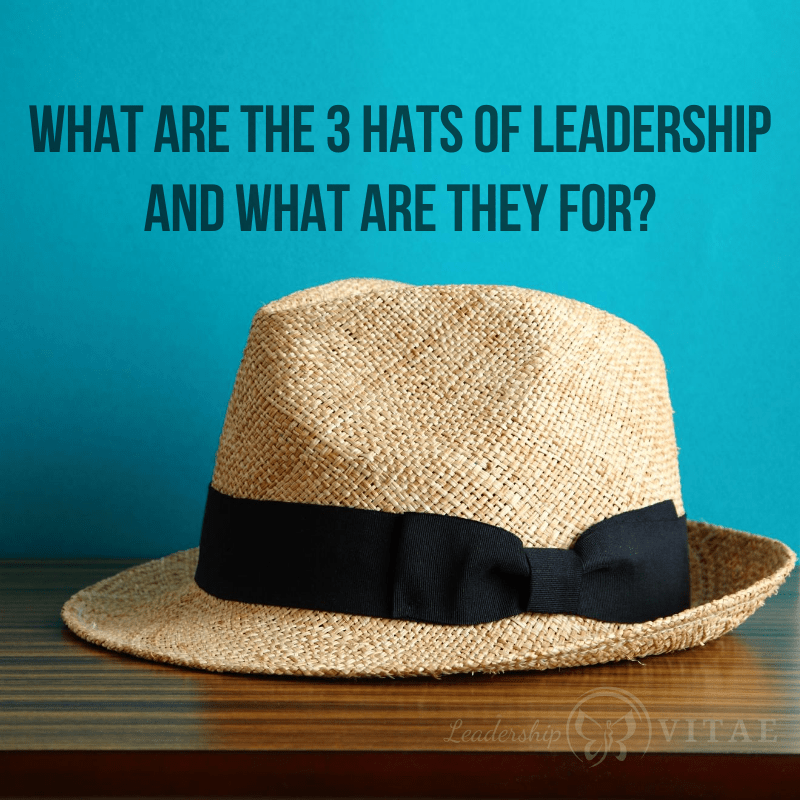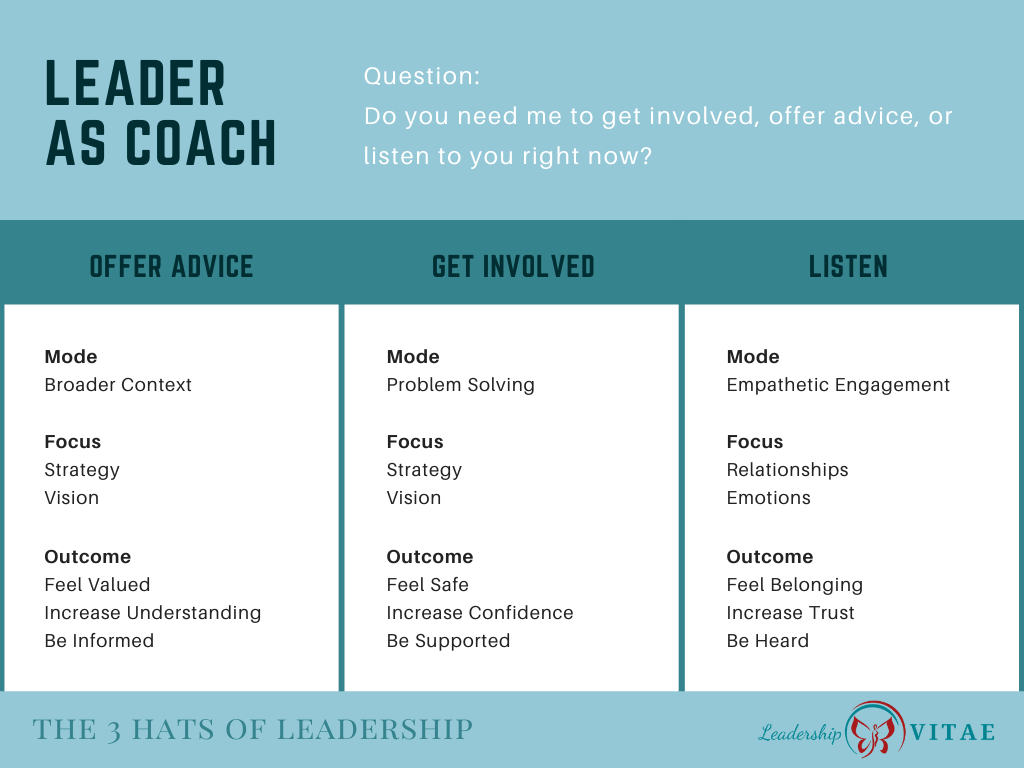
As part of embracing vulnerability, I’ve been pretty open with my struggle with social awkwardness, particularly as a leader. For a while now, I’ve been saying that having cue cards for interpersonal interaction would be hugely beneficial. Except…awkward.
Now that I’m working from home, I can totally get away with the cue cards. I am surrounded by post-it notes on my home desk. The most frequently used make it to the bottom edge of my monitor, where I can see them while I’m on calls.
Recently, I was in a discussion with one of my leaders, and I was able to reference one of my post-its. I’m very transparent about my journey, so that others can benefit from new tools and ideas, either for themselves or their teams. I happily shared the post-it, and we discussed how it helped guide our conversation.
The result was a model that outlined three distinct hats we often wear as leaders, and WHEN and WHY we’d wear each one.
Start with a question
I recently participated in a leader as coach certification program. Part of the program focused on asking different types of questions, with each type related to the way we show up as leaders. In some cases, a coach is needed. Other times, someone needs a mentor or a decision-maker.
While the concept was great, we ended up with six pages of various questions for different scenarios. I saved them, but who can memorize and recall that many options? And still feel authentically engaged and present in a conversation? Not me.
Well, one question that someone offered since then really stood out. It was offered by a parent for interactions with kids, but has proven amazing when engaging at work.
“Do you need me to get involved, offer advice, or just listen right now?”
Power in simplicity
The reason why I love this question, is it empowers the person engaging you AND you know how to show up in the interaction.
Often, leaders make their way up in an organization based on problem solving skills. However, as we become responsible for people, we need to empower them to solve problems without us.
Sometimes, it can be difficult to put aside a skill that we have been rewarded for and focus on developing that skill in others.
This simple question makes it clear which hat we need to put on. Do they need the expert problem solver? If that’s our default, this is a very direct cue when that version of us is not necessary.
Each answer offers a different opportunity to engage.
Offering advice
If we are asked for advice, usually this means an opportunity for broader context. Depending on our role in the organization, we probably have a particular perspective that’s being asked for.
This is often an opportunity to talk about strategy and vision. This could be of the team or organization, or even the individual. The strategy might be their career goals and aspirations, or could be the vision of the future balancing family and work commitments.
If we stick to advice, providing additional context for them to make their own decisions, we can increase understanding of options or risks. We can also help them feel valued and know where they fit in relative to organizational direction, and ensure they are informed on anything that might influence their decision.
Just listen
It might be difficult, but sometimes we need to hold our tongue. As a trusted advisor and problem solver, we may be the preferred sounding board for someone that is trying to figure out their own path.
When we are focused on listening, it’s time to practice empathetic engagement. Verbal and physical cues reflect our engagement. We can also ask the occasional clarifying question to show we want to understand.
While we might be chomping at the bit to offer our own advice, we’ve been signaled to save it. If ideas are swirling that have to come out, write them down. If asked later, they’ll be available.
Listening, without attempting to solve, allows a leader to focus on the relationship and various layers of what’s being shared. That may include emotions and interpersonal interactions, which are often missed when we go straight to solving.
Empathetic listening allows the person engaging with us to be heard and feel a sense of belonging. It also increases trust. We’ve honored their request and haven’t jumped in to fix something that they may be quite able to fix themselves.
Get involved
This is likely where a leader shines. I know I do. Problem solving is often a joy because as leaders we frequently give up the “doing” part of our role. When we are asked to help, we may feel the pull of challenge and purpose.
While we are in problem solving mode, it’s still great to ask questions. Rather than jump in to solve, start with asking questions about what has been considered or tried. Alternatively, ask where they need our help so we know where to begin.
Often, we are asked to get involved because it’s difficult to get to resolution, requiring a more senior person to push forward, or because air cover is desired. For example, if someone on the team is going to take a risk or try something new, maybe they want to make sure leader support will be there first.
By getting involved and helping solve the way our people desire of us, we can help them feel safe and supported in their endeavors. We can also increase their confidence in taking risks or trying new things.
Know your role
As leaders, we wear many hats. Knowing which one to wear at what time can be a challenge. When it comes to being a coaching leader, sometimes a simple question can point us in the best direction to begin.
The summarized model is below. What thoughts do you have on the three types of leader modes, focus areas, and outcomes? Please share your thoughts in the comments on the model or other ways to know which hat to wear.









